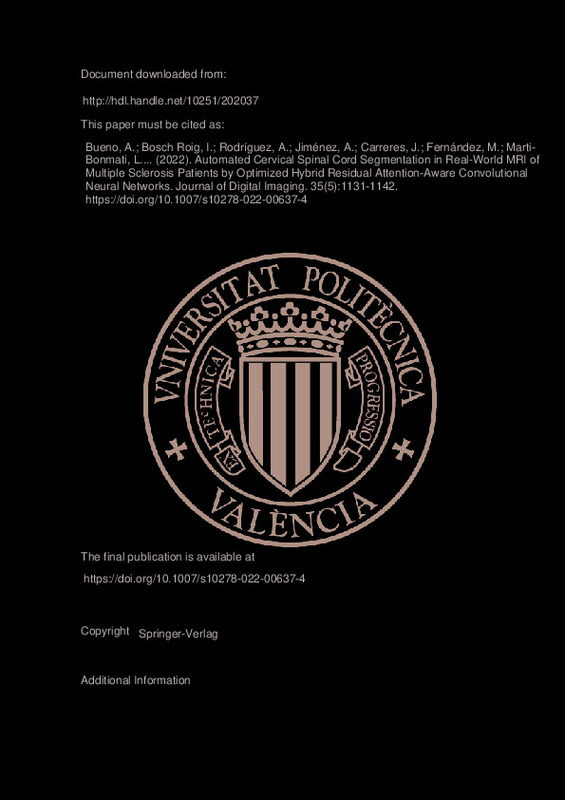JavaScript is disabled for your browser. Some features of this site may not work without it.
Buscar en RiuNet
Listar
Mi cuenta
Estadísticas
Ayuda RiuNet
Admin. UPV
Automated Cervical Spinal Cord Segmentation in Real-World MRI of Multiple Sclerosis Patients by Optimized Hybrid Residual Attention-Aware Convolutional Neural Networks
Mostrar el registro sencillo del ítem
Ficheros en el ítem
| dc.contributor.author | Bueno, América
|
es_ES |
| dc.contributor.author | Bosch Roig, Ignacio
|
es_ES |
| dc.contributor.author | Rodríguez, Alejandro
|
es_ES |
| dc.contributor.author | Jiménez, Ana
|
es_ES |
| dc.contributor.author | Carreres, Joan
|
es_ES |
| dc.contributor.author | Fernández, Matías
|
es_ES |
| dc.contributor.author | Marti-Bonmati, Luis
|
es_ES |
| dc.contributor.author | Alberich-Bayarri, Angel
|
es_ES |
| dc.date.accessioned | 2024-01-19T19:02:27Z | |
| dc.date.available | 2024-01-19T19:02:27Z | |
| dc.date.issued | 2022-10 | es_ES |
| dc.identifier.issn | 0897-1889 | es_ES |
| dc.identifier.uri | http://hdl.handle.net/10251/202037 | |
| dc.description.abstract | [EN] Magnetic resonance (MR) imaging is the most sensitive clinical tool in the diagnosis and monitoring of multiple sclerosis (MS) alterations. Spinal cord evaluation has gained interest in this clinical scenario in recent years but, unlike the brain, there is a more limited choice of algorithms to assist spinal cord segmentation. Our goal was to investigate and develop an automatic MR cervical cord segmentation method, enabling automated and seamless spinal cord atrophy assessment and setting the stage for the development of an aggregated algorithm for the extraction of lesion-related imaging biomarkers. The algorithm was developed using a real-world MR imaging dataset of 121 MS patients (96 cases used as a training dataset and 25 cases as a validation dataset). Transversal, 3D-T1 weighted gradient echo MR images (TE/TR/FA=1.7-2.7ms/5.6-8.2ms/12°) were acquired in a 3T system (SignaHD, GEHC) as standard of care in our clinical practice. Experienced radiologists supervised the manual labelling, which was considered the ground-truth. The 2D convolutional neural network consisted of a hybrid residual attentionaware segmentation method trained to delineate the cervical spinal cord. The training was conducted using a focal loss function, based on the Tversky index to address label imbalance, and an automatic optimal learning rate finder. Our automated model provided an accurate segmentation, achieving a validation DICE coefficient of 0.904±0.101 compared with the manual delineation. An automatic method for cervical spinal cord segmentation on T1-weighted MR images was successfully implemented. It will have direct implications like a previous stage for accelerating the process for MS staging and follow-up through imaging biomarkers. | es_ES |
| dc.description.sponsorship | This work was funded by a Generalitat Valenciana PhD fellowship (grant number ACIF/2017/057) and the Universitat Politecnica de Valencia and Polytechnic La Fe Hospital research project DeepMedul (grant number 2018/0274) (Deep Learning for spinal cord segmentation in Multiple Sclerosis). | es_ES |
| dc.language | Inglés | es_ES |
| dc.publisher | Springer-Verlag | es_ES |
| dc.relation.ispartof | Journal of Digital Imaging | es_ES |
| dc.rights | Reserva de todos los derechos | es_ES |
| dc.subject | Segmentation | es_ES |
| dc.subject | MRI | es_ES |
| dc.subject | Multiple sclerosis | es_ES |
| dc.subject | Deep learning | es_ES |
| dc.subject | Residual attention-aware | es_ES |
| dc.subject | CNN | es_ES |
| dc.subject.classification | TEORÍA DE LA SEÑAL Y COMUNICACIONES | es_ES |
| dc.subject.classification | EXPRESION GRAFICA EN LA INGENIERIA | es_ES |
| dc.title | Automated Cervical Spinal Cord Segmentation in Real-World MRI of Multiple Sclerosis Patients by Optimized Hybrid Residual Attention-Aware Convolutional Neural Networks | es_ES |
| dc.type | Artículo | es_ES |
| dc.identifier.doi | 10.1007/s10278-022-00637-4 | es_ES |
| dc.relation.projectID | info:eu-repo/grantAgreement/GVA//ACIF%2F2017%2F057/ | es_ES |
| dc.relation.projectID | info:eu-repo/grantAgreement/Hospital Universitari i Politècnic La Fe//2018%2F0274//Project DeepMedul. Deep Learning for spinal cord segmentation in Multiple Sclerosis/ | es_ES |
| dc.rights.accessRights | Abierto | es_ES |
| dc.contributor.affiliation | Universitat Politècnica de València. Escuela Técnica Superior de Ingenieros Industriales - Escola Tècnica Superior d'Enginyers Industrials | es_ES |
| dc.contributor.affiliation | Universitat Politècnica de València. Escuela Técnica Superior de Ingenieros de Telecomunicación - Escola Tècnica Superior d'Enginyers de Telecomunicació | es_ES |
| dc.description.bibliographicCitation | Bueno, A.; Bosch Roig, I.; Rodríguez, A.; Jiménez, A.; Carreres, J.; Fernández, M.; Marti-Bonmati, L.... (2022). Automated Cervical Spinal Cord Segmentation in Real-World MRI of Multiple Sclerosis Patients by Optimized Hybrid Residual Attention-Aware Convolutional Neural Networks. Journal of Digital Imaging. 35(5):1131-1142. https://doi.org/10.1007/s10278-022-00637-4 | es_ES |
| dc.description.accrualMethod | S | es_ES |
| dc.relation.publisherversion | https://doi.org/10.1007/s10278-022-00637-4 | es_ES |
| dc.description.upvformatpinicio | 1131 | es_ES |
| dc.description.upvformatpfin | 1142 | es_ES |
| dc.type.version | info:eu-repo/semantics/publishedVersion | es_ES |
| dc.description.volume | 35 | es_ES |
| dc.description.issue | 5 | es_ES |
| dc.identifier.pmid | 35789447 | es_ES |
| dc.identifier.pmcid | PMC9582086 | es_ES |
| dc.relation.pasarela | S\478034 | es_ES |
| dc.contributor.funder | Generalitat Valenciana | es_ES |
| dc.contributor.funder | Universitat Politècnica de València | es_ES |
| dc.contributor.funder | Hospital Universitari i Politècnic La Fe | es_ES |







![[Cerrado]](/themes/UPV/images/candado.png)

